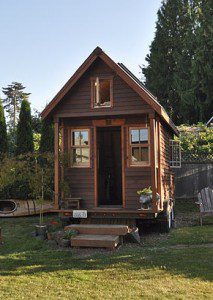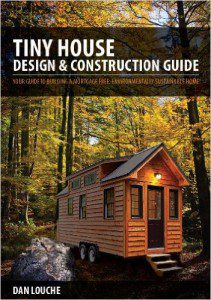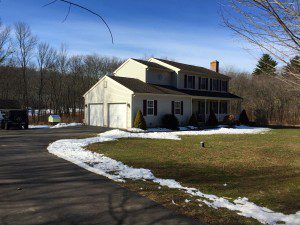
I’ve owned three houses. Besides those I’ve owned 6 apartment buildings with a total of 24 rental units. I think I’ve had roughly 60 or so tenants over the years.
Add to that all the real estate I helped people buy and sell as an agent (probably 80 or so) and the fact that I was a building contractor for a time, I think I know a little bit about houses.
In spite of these things, when it comes to housing, no one ever takes my advice. Sure, they ask, but later when I ask about what they’ve bought, without fail they’ve ignored what I’ve said and gone ahead and gotten what they would have gotten without getting my opinion.
I get it. A house meets emotional needs. I suppose my own need to own houses and be a landlord goes back to the insecurity I felt as a kid. We moved around a lot and always rented. When my father abandoned us when I was 11 I spent my teenage years in public housing.
So I know the things I have to say about the Tiny House movement will likely be ignored. But here goes anyway.

Two and a Half Cheers!
So how tiny is a tiny house? Really tiny. 200 square feet is roughly the norm. They can be as small as a walk-in closet in a McMansion though–under 100 square feet. On the large end of things they can get up to about 500 square feet. Beyond that you’re not tiny anymore, just small.
Often they’re on wheels, sometimes to circumvent building codes, other times because the owner is something of a gypsy, following the will-o-the-wisp in search of excitement on the road, other times because work beckons in another city.
The movement seems to be made up mostly of young people in their 20s, but I’ve seen older folk jumping on the band wagon.
Largely I think the movement is a healthy response to some of the excesses in the housing market over the last 20 years, but I do have a few concerns. I’ll get to those in a minute. Let’s take a look at a some of the things to cheer about.
Simplicity
If you’re going to live in 200 square feet, you’re going to need to get rid of stuff. (Unless you’re just getting started that is and haven’t had a chance to accumulate.)
Space constraints force you to ask, “Do I really need this?” You also tend to think about flexibility, things need to serve more than one purpose. For instance, in most of the tiny homes I’ve seen, stairs, and chairs, and beds all do double duty. For example, stairs tend to double as drawers for storage. It’s fun to see all the ways people do more with less in these homes.

Thrift
I think the biggest thing driving the tiny house movement is the cost of housing in many parts of the country. Since the subprime mortgage crisis of 2008 folks are less inclined to take on debt. Debt is always risky, so in a way you could say this is conservatism in action. I’m not sure how many of the tiny house folk would embrace that. They generally justify their actions with more progressive rhetoric–lowering their carbon foot-print, that sort of thing. But why should McMansion excess be synonymous with conservatism? I hope these folk are saving the money they’re not spending on housing. If they are, good for them.
DIY
DIY stands for “Do It Yourself”. Because the houses are so small, and the costs of construction are within reach for many young people, there is a hands on approach to the tiny house movement. Many young people who’ve had no exposure to the trades (often because they were discouraged from taking them up by well-meaning but misguided guidance counselors and parents) are learning to use tools. The skills and the confidence that comes with them will follow these folk throughout life.
Some craftsmen have begun building these homes for those who either can’t or are unwilling to build them for themselves. Of those folk my favorite is Zyl Vardos. Owner, Abel Zimmerman Zyl is an artist. His stuff is worth the premium you pay.
So, why not three cheers?
I hope you will take these criticisms in the spirit they are intended. I am largely an enthusiast, so much so that I’ve actually done a little preliminary legal work so that I can build some of these homes on the side one day. Still, I have at least three concerns.
Transience
Seems to me that one of the big selling points for tiny houses is their mobility. And this is a problem.
Rather than challenge the cult of choice made possible by globalization, tiny houses seem to just goes along with it. What we need is people who stay put, in good times and bad, who build local communities and help to recover what the locusts of global capital have eaten. If the tiny house movement is just one more way for people to keep from setting down roots, well, I’m against it. If it is a way to live inexpensively in a place you couldn’t afford to live in otherwise, I’m for it.
No room for productive property
Your long-term goal should be ownership of productive property. Paradoxically productive property gives you genuine economic freedom even though it ties you down. I’m talking about a garden, or a local business, those things. Today we substitute the phony freedoms of freedom of movement and free-sex for the real thing.
If you’re going to have productive property you’ll need space. I think one of the things about tiny houses on wheels that I can support is their possible repurposing. They can be turned into rental housing or a mobile office or a place to put people in need. What I’m getting at is they’re a great start, but you’ll need more if you truly want to be free.

No room for other people
If tiny houses only atomize our world even more than it already has been, I’m against them.
A household is not a building, it is people working together to shelter each other. It is a working concern, an economy–from the Greek, oikos for “house” and nomos for “law”. And for a household to last it needs children. And for children to honor their aged parents, there must be space for them.
Now tiny houses can actually be a solution to the atomization of our society if we use them to live closer to the people we should be caring for. They can be a great way for people to enjoy having kids nearby, but not too nearby, when they’ve finished college but don’t have places of their own, or for people with older parents to have a place to stay when caring for them.
I think the long term solution for our society is the recovery of intergenerational housing, something like the old triple-deckers you can still find on the east coast, where grandparents live on the first floor, parents on the second, and grown children on the third. Retrograde zoning laws stand in the way of recovering these traditional patterns of household life, but I’m hopeful that tiny houses can contribute to their recovery.
If the tiny house movement matures in the ways I’ve suggested, my two and a half cheers will become a full-throated three cheers.
















